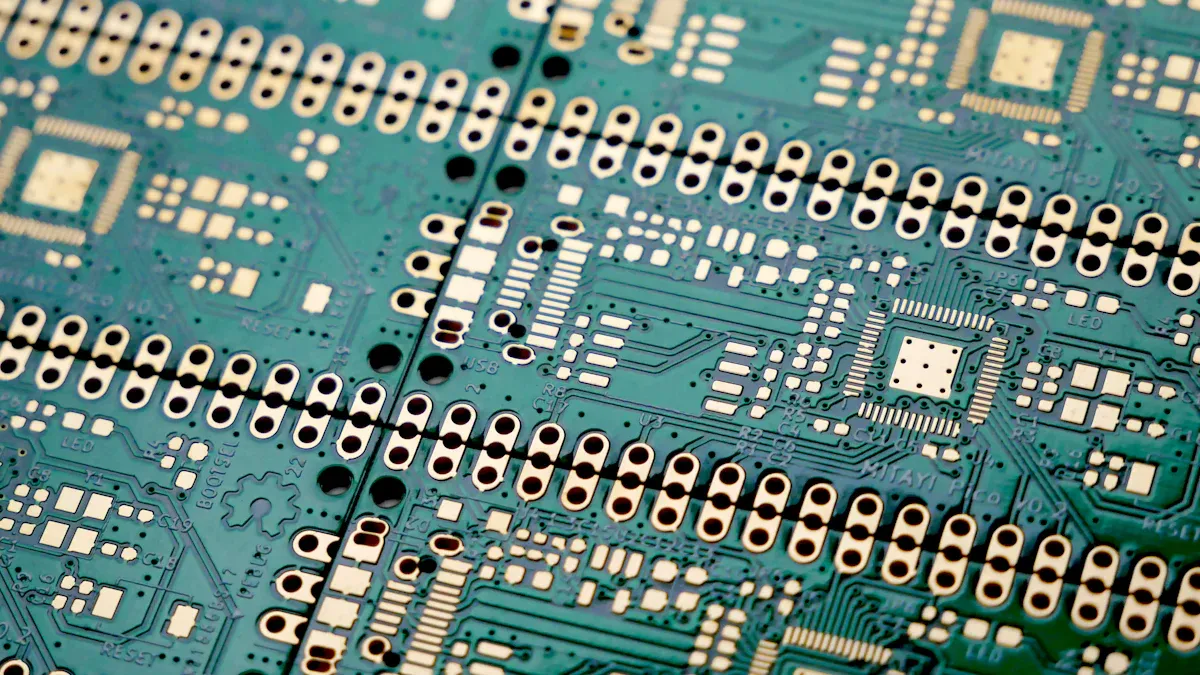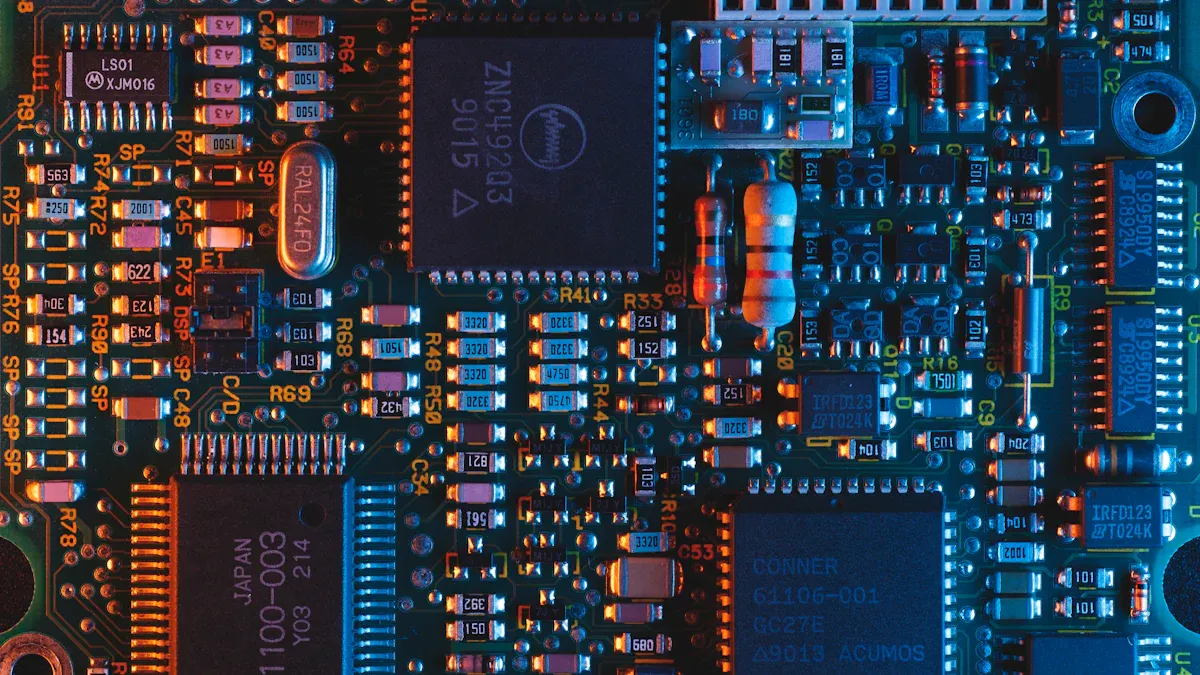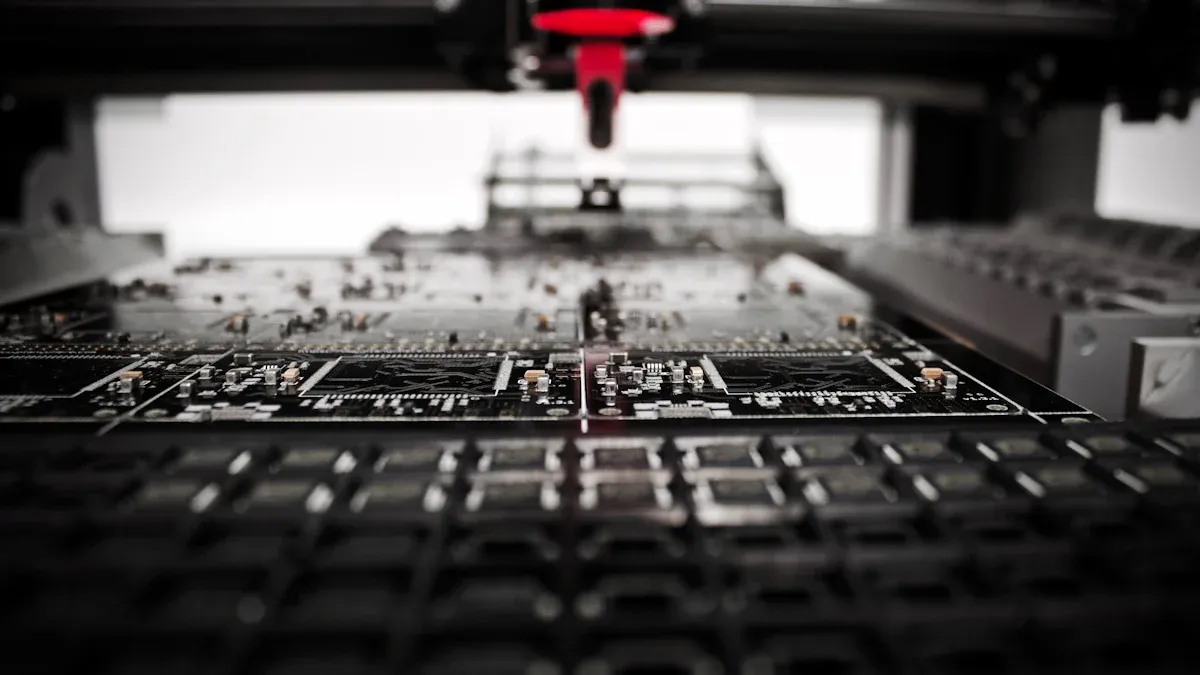Understanding ENEPIG and Its Role in PCB Manufacturing

ENEPIG, which stands for Electroless Nickel Electroless Palladium Immersion Gold, is a premium surface finish for PCBs. This advanced finish enhances performance by simplifying soldering and wire bonding processes while providing excellent protection against rust and physical damage. Its growing adoption across various industries highlights its effectiveness. In North America, 68% of PCB manufacturers utilize ENEPIG for aerospace applications, as it plays a crucial role in meeting the stringent reliability standards required in this sector.
Key Takeaways
ENEPIG is a high-quality PCB coating that improves soldering and wire connections. It also protects against rust very well.
The ENEPIG process uses layers of nickel, palladium, and gold. Each layer has a job to make it strong and work well.
ENEPIG works great for industries like aerospace and telecommunications. It lasts long and handles tough conditions easily.
What is ENEPIG in PCB Manufacturing?
Definition of Electroless Nickel Electroless Palladium Immersion Gold
ENEPIG stands for Electroless Nickel Electroless Palladium Immersion Gold. It is a top-quality surface finish used in making PCBs. This process adds three layers—nickel, palladium, and gold—on the copper surface of a PCB. Each layer has a job to make sure the PCB works well.
Material | What It Does | Thickness (Chemical Composition) |
|---|---|---|
Electroless Nickel | Stops rust and protects the PCB surface. | 3-6 µm |
Electroless Palladium | Protects nickel and helps with soldering. | 0.1-0.2 µm |
Immersion Gold | Makes the surface smooth and stops rust. | 0.03-0.1 µm |
The nickel layer blocks copper from spreading and keeps the PCB strong. Palladium adds extra protection and makes soldering easier. The gold layer gives a smooth surface and stops rust, which is great for important uses.
Importance of ENEPIG in Modern PCB Manufacturing
Why is ENEPIG so popular for PCB finishes? Its special features make it very useful in today’s electronics. Unlike older finishes, ENEPIG is great for soldering, wire bonding, and stopping rust. These features help PCBs work well even in tough conditions.
Surface Finish | Cost | Soldering Quality | Rust Protection | Shelf Life | Works With |
|---|---|---|---|---|---|
ENEPIG | High | Excellent | Excellent | Long, up to 24 months | Lead-free soldering, wire bonding, mixed assembly |
OSP | Low | Good | Moderate | Short, about 6 months | Lead-free soldering |
HASL | Low | Good | Moderate | Medium, about 12 months | Regular soldering |
ENEPIG is flexible and works with lead-free soldering, wire bonding, and mixed assembly. It lasts up to 24 months, keeping PCBs working for a long time. This makes it a great choice for industries like aerospace, cars, and telecom.
The way ENEPIG is applied also makes it effective. Each layer is added carefully to ensure the PCB performs well. Whether it’s for a gadget or a medical tool, ENEPIG gives the strength and reliability you need.
Tip: Need a finish that’s great for soldering, rust protection, and lasting long? ENEPIG is a smart pick for your PCB projects.
The ENEPIG Process in PCB Manufacturing

Step-by-Step Overview of the ENEPIG Process
The ENEPIG process uses several steps to create a strong PCB finish. Each step is important for making the PCB work well and last long. Here's a simple breakdown:
Step | Purpose | Process | Importance |
|---|---|---|---|
1 - Surface Preparation | Helps layers stick better | Clean with special solutions and etch with acid | Removes dirt and makes the surface rough for better sticking |
2 - Catalyst Application | Starts the nickel layer process | Add a palladium solution to the surface | Prepares the surface for nickel to attach |
3 - Electroless Nickel Deposition | Adds the first protective layer | Dip in a nickel bath at warm temperatures | Stops rust and creates a smooth base |
4 - Nickel Layer Activation | Gets nickel ready for the next layer | Soak briefly in a weak acid solution | Cleans the nickel for even palladium coating |
5 - Electroless Palladium Deposition | Adds a barrier between nickel and gold | Dip in a palladium bath at mild heat | Blocks nickel from mixing with gold and helps soldering |
6 - Immersion Gold Deposition | Adds the final protective layer | Dip in a gold bath at warm temperatures | Protects the layers and makes the surface smooth |
7 - Rinsing and Drying | Cleans off extra chemicals | Wash with clean water and dry with hot air | Leaves the surface clean and ready for use |
By following these steps, you get a strong and reliable ENEPIG finish. Each layer helps the PCB resist rust, solder easily, and last longer.
Materials and Techniques Used in ENEPIG
The materials and methods in the ENEPIG process improve how the PCB works. Each layer has a job, and careful checks make sure the process works well.
Material Layer | Quality Control Measure | |
|---|---|---|
Electroless Palladium | Stops rust and helps with bonding strength | Ensures PCBs work well in tough conditions |
Immersion Gold | Makes soldering easier and stops rust | Helps PCBs last a long time |
Palladium Layer | Makes bonds stronger and avoids black pad problems | Keeps PCBs strong in harsh environments |
The palladium layer stops nickel from mixing with gold. This keeps solder joints strong and wire bonds reliable. The gold layer gives a smooth, rust-proof surface, perfect for high-quality PCBs. Using these materials and careful techniques, the ENEPIG process creates excellent results for many uses.
Note: Keeping each step and material under strict control is key. This ensures your PCB is high-quality and dependable.
Advantages of ENEPIG for PCB Applications
Great for Wire Bonding and Soldering
ENEPIG is great for wire bonding, making it perfect for important uses like medical tools and aerospace. The palladium layer stops nickel from mixing with gold. This creates a smooth surface for strong wire bonds. ENEPIG works well even in tough conditions, giving reliable results every time.
Another big plus is its excellent soldering ability. It works with many solder types, including lead-free ones. This makes it very useful for modern PCB designs. Tests show ENEPIG wets faster than ENIG finishes. Edge dip tests also show no soldering problems, with solder spreading over 1.55 mm on all samples. These tests prove ENEPIG makes strong, reliable solder joints.
Did you know? ENEPIG lowers the chance of black pad issues. This problem can cause solder joint failures in other finishes. ENEPIG is a safer choice for critical uses.
Strong Against Rust and Long-Lasting
ENEPIG is great at stopping rust. Its nickel, palladium, and gold layers protect against moisture and chemicals. This keeps PCBs working well over time. Studies show ENEPIG-coated PCBs stay stable with no damage, even after aging tests. This proves they last long under normal use.
ENEPIG is tough in harsh places, making it ideal for cars and planes. These industries need PCBs that work in extreme conditions. ENEPIG also keeps PCBs solderable for up to 24 months. This long shelf life reduces failures and improves product reliability.
Key benefits of ENEPIG's rust protection:
Shields copper from damage caused by the environment.
Keeps PCBs reliable in tough conditions.
Extends PCB shelf life, keeping them solderable longer.
Works Well in Many Industries
ENEPIG is flexible and fits many PCB needs in different industries. It works with both lead-free and regular soldering. Whether for gadgets, telecom, or advanced computers, ENEPIG performs well.
Data shows ENEPIG’s adaptability. Wire bond tests show an average pull force of 12.3 grams, much higher than the 3-gram minimum. This proves it’s reliable for important uses. Its low electrical resistance makes it great for high-frequency telecom and computing. ENEPIG also passes solderability tests, ensuring strong connections in complex designs.
Pro Tip: Need a finish with great wire bonding, soldering, and rust protection? ENEPIG is the best choice for your PCB projects.
Applications of ENEPIG in Different Industries
Consumer Electronics and Telecommunications
ENEPIG is very important for electronics and telecom devices. It works well in small gadgets like smartphones and 5G systems. A 2024 study showed 72% of high-end phone boards use ENEPIG. This is because it supports 5G parts and complex PCB designs. In telecom, ENEPIG improves chip-on-board (COB) designs. These are used in AI chips and server GPUs for better performance.
Main uses in these fields:
Small devices like phones and tablets.
5G networks and advanced communication tools.
AI systems needing strong PCB designs.
Automotive, Aerospace, and Medical Devices
ENEPIG is a top pick for cars, planes, and medical tools. Its gold layer makes it great for high-performance tasks. It’s strong and resists rust, which is key for these industries. The plating process is also cheaper than ENIG.
No black nickel, avoiding corrosion problems.
Palladium stops copper mixing, keeping soldering easy.
Handles many lead-free soldering cycles.
These features make ENEPIG perfect for car controls, airplane systems, and medical imaging tools.
Advanced PCB Solutions by LT CIRCUIT
LT CIRCUIT is a leader in advanced PCB solutions. They offer ENEPIG finishes made for your industry needs. Whether for electronics, telecom, or aerospace, LT CIRCUIT delivers top-quality PCBs. Their skill ensures reliable PCBs for tough jobs.
Tip: Check out LT CIRCUIT’s ENEPIG finishes to improve your PCB projects.
ENEPIG vs. Other Surface Finishes

ENEPIG vs. ENIG
ENEPIG and ENIG are both common PCB finishes, but they work differently. ENIG (Electroless Nickel Immersion Gold) is known for its smooth surface and heat resistance. It’s easy to use and protects well against rust. However, ENIG can have problems like black pad issues and weaker wire bonding.
ENEPIG is better for wire bonding and soldering. It handles heat cycles better than ENIG, making it great for high-performance uses. ENEPIG also avoids black pad problems, creating stronger solder joints. While it costs more and needs careful processing, its reliability makes it a top choice for advanced PCBs.
Feature | ENIG | ENEPIG |
|---|---|---|
Advantages | Smooth surface, Heat-resistant | Great wire bonding, No black pad issues |
Disadvantages | Black pad risk, Weaker solder joints | Higher cost, Slower solder wetting |
ENEPIG vs. HASL
HASL (Hot Air Solder Leveling) is an older finish that uses melted solder to coat PCBs. It’s cheap and solders well. But HASL can leave uneven surfaces, which is a problem for dense PCB designs. It also doesn’t work well with lead-free soldering.
ENEPIG gives a smoother surface and works better with modern soldering. Its palladium layer makes solder joints stronger and stops rust. Unlike HASL, ENEPIG supports advanced designs, making it ideal for industries like aerospace and telecom.
ENEPIG vs. OSP
OSP (Organic Solderability Preservative) is a budget-friendly finish that protects copper with a thin organic layer. It’s good for simple PCBs but doesn’t last long and offers less rust protection. OSP also isn’t flexible enough for complex designs.
ENEPIG is stronger and more reliable than OSP. Its layers protect against rust and keep solderable for a long time. ENEPIG also works well with mixed assembly, making it the better choice for important projects.
Tip: Need a finish that’s durable, solders well, and bonds wires strongly? ENEPIG is your best bet for PCB projects.
ENEPIG is a strong and flexible choice for better PCBs. Its nickel, palladium, and gold layers help with soldering and bonding wires. ENEPIG also protects PCBs from rust and breaking over time. LT CIRCUIT provides top-notch ENEPIG finishes to meet today’s industry needs.
Its tough layers make it great for gold wire bonding.
Protective coatings stop rust, improving how PCBs perform.
FAQ
Why is ENEPIG better than other PCB finishes?
ENEPIG is great for bonding wires and soldering. It also stops rust well. Its layers make it last longer, which is perfect for uses like planes, cars, and telecom. ✨
Can ENEPIG work with lead-free soldering?
Yes, ENEPIG works well with lead-free soldering. The palladium layer makes solder joints strong. It meets modern rules and works for advanced PCB designs.
How does ENEPIG make PCBs last longer?
ENEPIG has nickel, palladium, and gold layers. These layers stop rust and protect from damage. This keeps your PCB working well, even in tough places. 🛡️
See Also
How LDI Applications Enhance PCB Product Quality Significantly
Enhancing PCB Production Yield Rates Through Online AOI Technology
Vacuum Two-Fluid Etching Machines: Key to Precision PCB Manufacturing
Utilizing Horizontal Copper Sinking Technology for PCB Manufacturing
Essential Knowledge for Designing Multi-Layer PCB Circuit Boards
